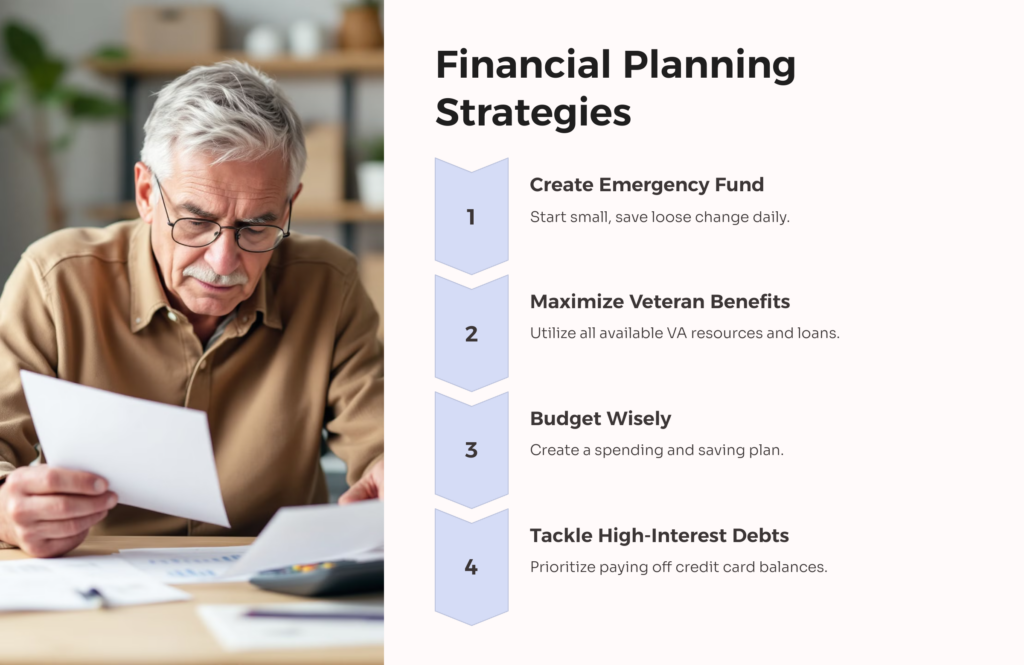Recent budget proposals by the Congressional Budget Office (CBO) propose a cut in monthly benefits for veterans with disabilities. This would happen if their annual household income, once adjusted for inflation, exceeds a particular dollar mark. That’s shocking for many veterans. And many want to know if the VA will slash their disability compensation in 2024. At Allveteran, we can help answer most of your questions concerning veteran disability cuts. Here is what we know so far about this crucial matter.
Understanding VA Disability Benefits

The Department of Veterans Affairs (VA) offers monthly tax-free compensation to United States military veterans. This compensation goes to veterans who get injured or become sick while serving in the military and those whose condition deteriorates due to service. You might qualify for VA disability compensation for mental health conditions like PTSD. You may also be eligible for these benefits if you have physical conditions like injuries or chronic sickness that developed during, before, or after military service.
However, you must meet a threshold of eligibility criteria to qualify for any VA benefits. To be eligible for VA disability benefits, you must have:
- Received a discharge under conditions other than dishonorable,
- And been on active service.
After meeting these requirements, you must also meet additional conditions for the specific benefit programs.
The VA offers disabled veterans many benefits, including medical and cash payments. These are the most common benefits that disabled veterans can receive:
- Service-related disability compensation or VA disability benefits
- VA pension
- Combat-related Special Compensation (CRSP)
- Concurrent Retirement and Disability Payments (CRDP)
- VA health care
- VA nursing home care
You may also qualify for home loan guarantees and education benefits.
Recent Changes and Proposed Cuts
CBO releases budget proposals to decrease the federal deficit yearly through many options. The CBO released these proposals in 2022 and aimed to reduce veteran disability benefits for many veterans. The proposals also aimed to stop disability benefits for veterans with an annual household income of over $170,000. This proposal came at a time when VA disability payments have increased continually since 2000 despite a decrease in the number of veterans across the United States. This shift is because of increased disability payments because of the PACT Act and similar initiatives that have increased the number of people who qualify for disability compensation.
According to this proposal, disabled veterans who have an annual household income of less than $125,000 will receive full VA disability pay. Data shows that over 1.5 million military veterans out of 5 million veterans who get disability payments–exceeded this income threshold in the last four to five years. This proposal includes mean-testing for current and potential military veterans who wish to receive VA disability benefits–beginning January 2024–and wouldn’t include any addendums depending on the number of family members in a household.
The second proposal by CBO looks to end TDIU (Total Disability based on Individual Unemployability), or 100% disability compensation rate for military veterans who can’t work after retirement age. As a military veteran, this budget proposal may directly affect you in one of these two ways:
- Under the first option, the Department of Veteran Affairs will stop making TDIU payments to military veterans aged 67 or older (this is the full retirement age for Social Security (SS) benefits for veterans born after 1959). This limitation would apply to both current and prospective recipients. Once you reach 67, your disability pay will revert to the amount related to your disability rating.
- The second option affects military veterans receiving TDIU payments after December 2023. Here, you’d no longer receive TDIU benefits once you reach 67, and all new applicants aged 67 or older would no longer be eligible for TDIU payments after that date.
Factors Contributing to Potential Cuts
The U.S. might be the largest economy in the world, but it’s facing a huge deficit. As of the start of the fiscal year 2023, that deficit was around $723 million. This number is worrying, and the government is constantly looking for ways to reduce it to a manageable amount.
Thus, the CBO has been brainstorming ways to lower the federal deficit. The most contentious idea is that the government can save nearly $253 million in the next decade by eliminating disability payments for veterans who earn over $170,000. That calls for mean-testing for wealthy veterans.
That means that if your gross household is less than $125,000, you’ll get total disability payments. But if your gross household income is more than $125,000, your disability payments would decline, with a decrease of one dollar for every two dollars you earn above the threshold.
Impact on Veterans and Their Families

The VA disability cuts would:
- Endanger Medical Care for military veterans. The disability cuts would result in 30 million fewer military veteran outpatient visits, and nearly 81,000 jobs would be lost across the Veterans Health Administration. This would leave many veterans unable to get appointments for cancer screening, wellness visits, substance use disorder treatment, and mental health services.
- Threaten access to telehealth services. Access to remote health care via telehealth is fundamental for veterans, especially in rural areas. By cutting funds for vital IT infrastructure and support, the VA disability cuts would undermine the VA’s ability to scale video-to-home telehealth services. This would also limit the medical equipment the VA can offer to veterans so that they attend crucial telehealth appointments from home.
- Cut housing for military veterans. Each military veteran deserves a good home in a country they fought to defend. Sadly, disability cuts would eliminate funds for Housing Choice Vouchers for many veterans, putting many of them at risk of homelessness.
- Increase food insecurity among veterans. Nearly 1.2 million military veterans rely on the Supplemental Nutrition Assistance Program (SNAP). Unfortunately, VA disability cuts would take food aid away from older veterans by introducing bureaucratic, burdensome conditions, limiting the nation’s ability to protect vulnerable people currently subject to work requirements. This would ultimately increase the probability that military veterans and their loved ones go hungry.
Legal and Advocacy Resources
Life after serving in the military can pose new challenges, such as returning to school, finding a job, finding others who understand your story, and navigating disability compensation. Thankfully, Veteran Service Organizations (VSOs) can help military veterans before, during, and after the transition period.
Some VSOs can help you file VA claims, some lobby Congress to extend or maintain VA disability benefits, and others provide networking opportunities.
The American Legion is one of the largest VSOs offering national and local activities focusing on equipping communities with diverse programming. Also, American Legion Posts employ veteran service officers who help military veterans and their loved ones navigate their compensation, including the application process.
AMVETS National Service Foundation is another VSO that helps military veterans navigate through the VA’s disability process.
Further, the National Veterans Legal Services Program (NVLSP) advocates for veterans and their families to receive the disability benefits they deserve. This VSO works with the Vietnam Veterans of America and the Military Order of the Purple Heart to keep fellow advocates and volunteers updated on advocacy techniques and laws.
Navigating the Appeals Process
If you have been diagnosed with a mental or medical health condition that’s connected to your military service, you might qualify for disability benefits from the VA. Although the process of filing for VA compensation is easy, it can sometimes result in unfair decisions.
If your disability claim is denied or you’re unhappy with your disability rating, you can file an appeal.
An appeal helps you to file a motion to modify the decision made by a local VA office. The Board of Veterans’ Appeals reviews and makes decisions concerning VA appeals.
Before venturing into the appeal process, carefully review the decision letter from the VA. This helps you understand why your VA claim was denied or underrated. This letter offers specific reasons for the decision and is vital in preparing your appeal.
Next, decide your appeal path. There are three primary paths for appealing the VA decision:
- Higher-Level Review Lane. Here, a more senior VA staff member will review your disability claim, and you do not need to submit any new evidence.
- Supplemental Claim Lane: This allows you to submit new, relevant evidence not considered in the initial hearing.
- Board of Veterans’ Appeals Lane: Here, you can appeal directly to the Board, and you have many options, such as having a hearing, submitting more evidence, or opting for a new review with no additional evidence.
Collecting new and relevant evidence is essential if you choose the Boards of Veterans’ Appeals or Supplemental Claim Lane with additional evidence. That may include statements from fellow service members, medical records, or other documents that support your disability claim.
The submission process will vary depending on the appeal path you choose. You must complete and submit VA Form 20-0996 for a Higher-Level Review. For a supplemental claim, you must submit VA Form 20-0995; for the Board of Veterans’ Appeals Lane, you’ll need VA Form 20-0996. Make sure you fill out all the forms accurately and comprehensively.
Once you’ve submitted your appeal, remain proactive. You might be required to undergo additional medical examinations or provide more information.
After the VA makes its decision, you’ll receive a letter detailing the outcome. If your appeal is successful, it’ll outline your new disability rating and payments. If not, you can continue the appeal process and seek further assistance.
Alternative Support and Benefits
Elderly veterans may qualify for several benefits available to all United States military veterans. These veteran benefits include pension, disability payments, health care, education and training, insurance, home loans, burial, and Veteran Readiness and Employment.
Two VA programs offer some elderly veterans additional compensation if they’re eligible for or receiving VA pension pay.
Housebound is an additional monthly pension compensation paid if you’re substantially confined to your immediate household due to a permanent disability.
Aid and Attendance is an additional monthly pension compensation paid if you meet any of the following requirements:
- You’re bedridden;
- You require assistance performing everyday activities, like eating, bathing, or dressing;
- Your eyesight is capped to a corrected 5/200 visual acuity or less for both eyes; and
- You’re a patient in a nursing home.
Veterans might also be eligible for Social Security Disability Insurance (SSDI) or Supplemental Security Income (SSI) as an alternative to or in conjunction with VA disability compensation. Further, they can use the Medicare and Medicaid health benefits that come with SSDI/SSI to supplement VA health services.
Financial Planning and Budgeting Strategies

Saving money is essential for many, but it can be daunting for military veterans with unique financial challenges, especially if they’re just returning to civilian life after military service. Luckily, these four simple tips can help you manage your finances effectively in light of potential cuts to VA disability payments.
Create an Emergency Fund
Emergency funds are crucial for everyone, especially veterans who may have unexpected costs connected to service-related disabilities and other medical issues. A great way to do this is to start saving your loose change. Saving fifty cents daily in a year can allow you to save about 20% of a $1,000 emergency fund. Start small and put aside more money as you go on.
Maximize Your Veteran Payments
As a veteran, you can access many benefits, including home loans, education benefits, healthcare compensation, and other VA loans. In light of potential cuts to VA disability benefits, you can maximize these resources to save hundreds, if not thousands, of dollars over time.
Create a Spending and Saving Plan
Budgeting is the backbone of any successful savings plan. Thus, you must create a spending and saving plan or a budget to help you understand your finances.
A budget can also help you understand where to make cuts. It can also help you set financial goals, plan for upcoming life events, and feel more empowered and in control on your journey to financial stability. Monitor your expenses and income, set realistic goals, and make adjustments where necessary. This can help you identify areas where you can save and prioritize your spending.
Prioritize High-Interest Debts and Loans
Paying off high-interest debts, such as credit card balances, can save you significant amounts of money over time. Prioritize paying off high-interest debts first and then handle low-interest loans.
Mental Health and Wellness Resources
Often, service members who experience trauma return home with invisible wounds. Upon returning to civilian life, some veterans may experience nightmares, hypervigilance, or intensified conflicts with loved ones. Although many can recover with adequate support, others might need additional help to feel better.
Taking care of your mental health and wellness is just as crucial as maintaining physical fitness. Your mental wellness is vital in helping you function optimally and achieve your goals.
Fortunately, when you seek help, you have many options to consider. Depending on your situation, you might seek care through the VA, the Department of Defense, your current employer, or other avenues.
Besides traditional psychological healthcare, you can also seek care through:
- Military OneSource. This free service points military veterans to the most beneficial mental wellness resources for their medical needs, such as confidential counseling.
- Peer-to-peer counseling. You can also talk to fellow veterans about your career, challenges, and personal life.
Many other options exist if you’re worried about stigma from those around you. Many non-profit organizations provide free mental health services for veterans and their families. For instance, you can contact the Wounded Warrior Project to get the help you need to get better.
You can also seek mental wellness care through the health insurance marketplace, Medicaid, or an employer-sponsored health insurance plan.
Community and Peer Support Networks
Community and peer support are crucial elements in overcoming mental health conditions, especially among veterans. These forms of support play vital roles in veteran recovery, as they offer shared empathy and understanding that are hard to find anywhere else.
Often, veterans face distinct challenges connected to their service, complicating the road to recovery. The concept of community and peer support in veteran recovery leverages the shared background, promoting a space where empathy and understanding flourish.
Peer support fosters the sharing of experiences. When veterans engage in community and peer support, they share stories and experiences that resonate deeply. This encourages a sense of understanding and solidarity. For instance, a veteran sharing the challenges of readjusting to civilian life may find comfort in learning others have experienced the same challenge. This isn’t just comforting–it’s empowering.
Community and peer support networks also help in reducing isolation. Many military veterans feel isolated because of their unique experiences in the military. Community and peer support networks bridge this gap. They create a community where veterans feel seen, heard, and understood.
These networks also play a crucial role in reducing veteran suicides, providing a timely and empathetic ear during crises. Through peer groups, veterans get immediate support from others who understand their challenges. This creates a safety net, often identifying warning signs early. The existence of a relatable support system can be a bloodline, providing connection and hope when it’s needed.
Several reputable initiatives and organizations offer veterans fundamental community and peer support, which is vital to their recovery journey. A notable example is the Veterans Crisis Line, which provides immediate help for struggling veterans.
Another well-known organization is The Wounded Warrior Project, which offers services and programs custom-made to meet veteran needs. These organizations and others form a pivotal support network, ensuring veterans access the assistance they need.
Conclusion: VA Disability Cuts
Potential cuts to VA disability compensation pose a significant challenge for veterans and their families. These disability benefits are vital for offering support and stability to veterans who have sacrificed a lot for their country. Thus, policymakers must consider these reductions’ lasting impact on veterans and their families and explore alternative options. Our duty to those who have fought for this country must remain unwavering, ensuring they get the support and care they need.
At AllVeteran, we recognize the sacrifices of our veterans by offering them the resources they need to secure the benefits they deserve. Visit our website to learn more about veteran and military benefits.
 AllVeteran.com Advisors
AllVeteran.com Advisors
With expertise spanning local, state, and federal benefit programs, our team is dedicated to guiding individuals towards the perfect program tailored to their unique circumstances.











